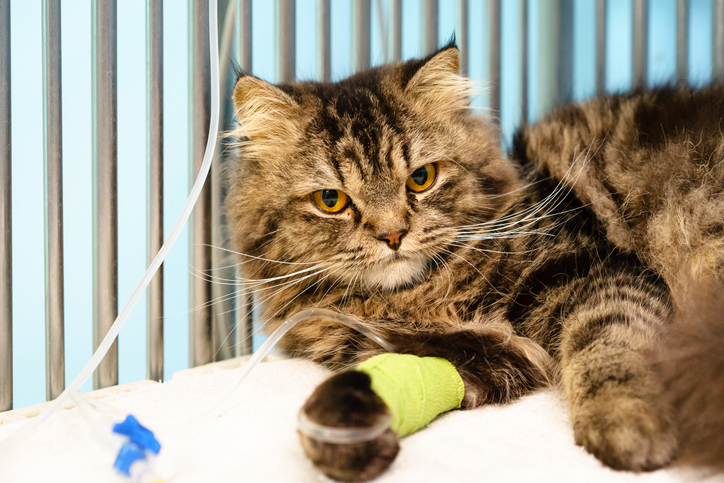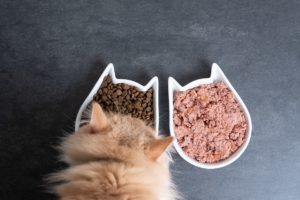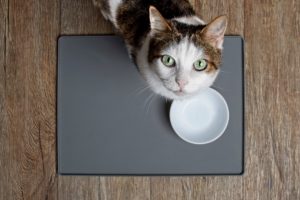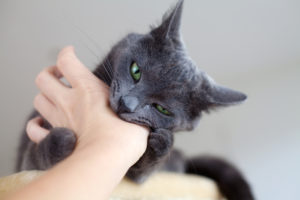Written by: Allison Ward
Has your cat been diagnosed with diabetes? Are you waiting for lab results and wondering what your vet will recommend if your cat IS diagnosed with diabetes? Or—have you had a diabetic cat for years, and are wondering how to treat diabetes in cats and ensure your cat is as healthy as she can be? You’ve come to the right place!
Diabetes in cats is an increasingly common diagnosis. Most diabetic cats are overweight, and show signs of diabetes in cats prior to labwork confirming the disease. This labwork usually includes blood testing showing elevated levels of blood glucose, urine testing that shows sugar being lost into your cat’s urine, and possibly a fructosamine test to see what your cat’s average blood sugar has been over the past several weeks.
There are two important aspects of treating cats who are diagnosed with diabetes mellitus: feeding an appropriate low-carbohydrate diet, and administering insulin injections every 12 to 24 hours, depending on your veterinarian’s instructions.
AskVet Tip: It’s useful to think about insulin and blood sugar (glucose) levels as a seesaw—when one goes up, the other goes down! After meals, blood sugar spikes and a healthy pancreas releases insulin, which works to bring blood sugar down. When you are giving your cat insulin injections, the insulin will ALWAYS lower the blood sugar.
Insulin Injections
Since cats with diabetes cannot release enough insulin to effectively lower their blood sugar, or may have developed insulin resistance (where the body’s cells don’t “listen” to the insulin), it is necessary to give diabetic cats extra insulin. This is provided by insulin injections. Administering insulin is always a bit of a trial and error process – all cats respond very differently to insulin! Avoiding hypoglycemia (dangerously low blood sugar from too much insulin) is just as important as addressing that hyperglycemia (high blood sugar). Sometimes it takes several months and vet visits to hone in on an effective dose for your kitty!
AskVet Tip: We know that many pet parents are intimidated when asked to give injections to their cats. Fortunately, there are many videos available online from YouTube and veterinary hospital websites that show you how to safely and consistently give insulin injections. We promise that, after establishing a routine, giving insulin shots will be “no big deal” to either you or your cat!
If your cat is newly diagnosed with diabetes, your veterinarian will schedule an appointment for a lesson in how to measure and administer insulin injections. Different types of insulin have different methods of handling, so it’s important to pay attention to ALL of the instructions offered and to ask questions—and even take notes!—during this appointment.
Types of Insulin
There are several insulin options for diabetic cats. Different types of insulin last for different lengths of time in the body, and may be labeled as long-acting, medium-acting, or mixed.
Most cats are started on insulin injections every 12 hours, so pick an injection time that will be the easiest to commit to being home with your cat on a consistent basis.
Over time, your cat’s insulin dose and even insulin type may be changed by your veterinarian based on your cat’s response and overall health status. Most cats do best on long-acting insulin known as glargine (brand name Lantus), but some cats do better on different insulin (Vetsulin, ProZinc, Humulin-N). Since different types of insulin work different ways in the body, it is essential to NEVER CHANGE THE TYPE OR DOSE OR TYPE OF INSULIN UNLESS IT IS ON THE DIRECT ADVICE OF YOUR VETERINARIAN.
In addition, it is important to always keep in mind the see-saw relationship of glucose and insulin. Insulin will ALWAYS lower blood sugar. If your cat is not eating well, make sure to adjust the dose of insulin as directed by your veterinarian. This is a great topic to discuss at your training session for insulin injections!
If your cat is not eating, or if she skips a meal, make sure to let your veterinarian know and/or reduce the amount of insulin you give. Always keep in mind if your cat has not eaten and you administer the regular dose of insulin their blood sugar may dip dangerously low putting them at risk of seizures, coma, and even death. (A typical recommendation is that, if your cat refuses a meal, only give half the prescribed normal volume of insulin.)
All of this may sound scary, and the caretaking of a diabetic animal requires a diligent and educated cat guardian. Fortunately, you’re in the right place with support from your family veterinarian and your AskVet Care Team!
Diets for Diabetic Cats
You probably know that cats are hunters at heart! They have evolved to eat several small, protein-heavy meals throughout the day. In the “wild,” this means frequent meals of songbirds, lizards, rodents, and other small animals. You can imagine that this “wild” cat diet contains very few carbohydrates—and you would be right!
When any animal ingests carbohydrates, the blood sugar levels rise, causing a release of insulin from the pancreas. In diabetic cats, there is usually not enough insulin in the pancreas to effectively lower the blood sugar, leading to sustained high blood glucose levels.
In order to maintain normal blood sugar levels, diabetic cats need extra insulin (in the form of injections), AND a reduction of dietary carbohydrates responsible for those spikes in blood sugar. In cats with diabetes, a diet low in carbohydrates is essential in order to achieve blood sugar control. Note that this does not mean “no carbohydrates at all”—a small amount of carbohydrates in the correct ratio to protein is also very important. In other words, cats can’t survive by protein alone!
High Protein Low Carb Diet
If you’ve read about the pros and cons of wet food vs dry for cats, , you already know that dry cat food automatically contains significantly more carbohydrates than wet food. This is due to how the kibble shape is formed and the ingredients stuck together. Dry food is RARELY an optimal diet for diabetic cats because of the inherently high ratio of carbohydrates to protein. Instead, a high-protein, low-carb canned food is the healthiest option for almost all diabetic cats.
Fortunately, there are some prescription foods that are made specifically for the needs of diabetic cats and that maximize the chances of your cat achieving remission of her diabetes (see details on remission later). These include Purina Veterinary Diets DM, Royal Canin Glycobalance, Hill’s Science Diet m/d, and Hill’s Science Diet w/d. If feeding a prescription food is outside of your budget, ask your veterinarian for low-carbohydrate over-the-counter canned foods that might be appropriate for your diabetic cat.
How often should you feed your diabetic cat?
There is no easy answer to this question! Giving an insulin injection will lower your cat’s blood sugar (see below), even if they have not eaten in a while.
Many veterinarians recommend feeding diabetic cats twice daily, immediately prior to insulin injections—so that we can be sure the insulin will not cause dangerously low blood sugar levels. (Remember, if a cat eats a meal, the blood sugar will always increase!)
However, for stable and otherwise healthy diabetic cat patients, feeding multiple times per day may help keep blood sugar levels more consistent over a 24-hour period. The safest course of action is to ask your family veterinarian what he or she recommends for your individual cat.
Monitoring Signs of Diabetes at Home
There are several methods your veterinarian may use to monitor your diabetic cat’s overall health and response to current diet and insulin administration. At home, monitoring your cat’s urination, appetite, and body weight are fantastic ways for you to keep track of improvements in your cat’s health, or the potential need for changing treatment plans!
Smaller clumps in the Box
Prior to your cat’s diagnosis of diabetes, you may have noticed that your cat is “flooding” the litterbox, with larger and more frequent clumps of urine. As your cat starts to respond to insulin injections and diet changes, these clumps should become smaller and less frequent. Also, you will hopefully notice that your cat’s thirst levels decrease, and that you are filling the water bowl or water fountain less frequently than before. However, if you notice MORE urine in the litterbox, or if your cat is drinking MORE, it’s time to call your vet—a change may be needed!
Gain Muscle Mass
Weighing your cat every week or two can help, too. Some diabetic cats start out overweight, and weight loss is expected and desired as we treat the underlying diabetes mellitus. However, some cats are diagnosed with diabetes after losing a significant amount of weight—and for these cats, weight GAIN (in the form of lean muscle mass) is desired.
An infant scale can be used at home to keep track of changes in your cat’s body weight, and your veterinarian can guide you as to the goals for your individual kitty.
Home Monitoring of Blood Glucose (Blood Sugar)
Did you know that you can monitor your cat’s blood sugar at home? You may be used to human diabetic friends pricking their finger frequently to check their blood sugar using a handheld device called a “glucometer.”
Glucometers
While human glucometers are not accurate for cats, there are veterinary specific glucometers that ARE accurate—and can even be ordered online, through Amazon and other online retailers. (A favorite brand among many veterinarians is the Alpha Trak 2.) Your veterinarian can teach you how to gently prick the skin of your cat’s ear tip, paw pad, or other location in order to get a drop of blood for instant testing at home.
Being able to test blood sugar at home is an excellent tool to have in a cat owner’s diabetic kitty parent toolbox. If your cat is showing symptoms of low blood sugar (like being lethargic, weak, “spaced out,” or not responding), you can immediately check their blood sugar to know if you should smear syrup on their gums and take them to the hospital, or if there is something else going on.
Continuous Glucose Monitor (CGM)
Nowadays, there is an even more convenient way to monitor your cat’s blood sugar at home: a continuous glucose monitor (CGM)! These are small sensors that are temporarily attached to your cat’s skin, and allow you to use a smartphone to scan and reveal your cat’s blood sugar immediately—without a pinprick!
In addition, these devices store hours of blood sugar information at a time, and can be used by both you and your veterinarian to track your cat’s response to treatment, and to evaluate whether remission has occurred. Often, these devices are attached during a short veterinary visit, and your veterinarian can monitor your cat’s blood sugar levels remotely, thanks to the cloud!
Blood Glucose Monitoring by the Veterinary Team
Your veterinarian will establish how often your cat should be rechecked at the veterinary office, and what tests are needed to check for diabetes regulation, as well as any complications from diabetes. At the initial diagnosis, it can take some time – one to two months or longer – for the best insulin dosing regimen to be determined. During this time, close monitoring of the blood glucose and any diabetes symptoms are essential.
Fructosamine Level Test
Your veterinarian might recommend a blood test called a fructosamine level test to see what your cat’s average blood sugar level has been over the previous several weeks. However, a fructosamine level has limitations and does NOT give any indication as to whether blood glucose peaks are too high, if they last too long, or if your cat’s blood sugar levels dip dangerously low throughout the day.
Home Glucose Curve
To better inform the selection of your cat’s insulin dosage and type, it is necessary to evaluate your cat’s blood glucose level throughout the day. This is traditionally done by performing a “glucose curve” test. The glucose curve is an all-day test, where blood samples are taken prior to receiving insulin and eating, and then every hour or two afterwards—ideally until the next dose of insulin is due twelve hours later.
Glucose Curve at the Veterinary Hospital
If a cat parent is comfortable using a glucometer at home (such as the Alpha Trak—see above!), then you may perform this test at home and your veterinarian will interpret the results and evaluate your cat’s current plan for any changes that are needed. Blood sugar levels are more accurate in cats when they are relaxed and in their home environment!
However, for cats who are not amenable to home blood sugar testing, your vet may recommend making a drop-off appointment to spend the whole day at the clinic for the veterinary team to obtain samples.
For veterinarians and cat parents who are comfortable using the CGM technology that we discussed earlier, these devices can be an excellent substitute for glucose curves. However, sometimes, a traditional glucose curve is needed if there are concerns about accuracy of the CGM readings.
Monitor Other Issues and Potential Diabetes Complications
Aside from blood sugar monitoring, it is also important to watch for other issues and potential diabetes complications, too! For example, since bacteria thrive in urine when glucose is present, samples may be taken for a urine culture to check for a urinary tract infection. Since these are so common in diabetic cats, urine cultures may be recommended every three to six months as well.
Did you know that high blood pressure can be seen in diabetic cats, just like diabetic people? Your veterinarian may recommend screening your kitty for this problem by measuring a blood pressure at the time of diagnosis, and rechecking their blood pressure every three to six months.
Additional bloodwork to evaluate the health of other internal organs such as the liver and kidneys will also be recommended at a schedule unique to your precious purrbox. Diabetes can have effects on many organs in the body, and problems elsewhere can affect your cat’s blood sugar levels and response to insulin. A full picture of your cat’s health is obtained by evaluating bloodwork, urine testing, and blood pressure!
A Word About Diabetic Remission in Cats
Since most cats have type II diabetes (diabetes mellitus) , there is a good chance of REVERSING your cat’s diabetes! This is known as diabetic remission, and has been reported in 25-50% of all newly-diagnosed diabetic cats. Cats in remission from diabetes no longer need insulin injections, and are considered “cured” from diabetes—however, they are at risk of developing diabetes again at any point in the future.
Every cat parent wants their diabetic kitty to be one of the lucky ones who go into remission! Our chances of achieving remission are maximized by:
– Early diagnosis (this means having your cat checked by a veterinarian as soon as common signs of diabetes in cats are noticed!)
– Proper diabetic cat diet (low-carb and high in protein—ideally a prescription diabetic cat diet)
– Using the best-quality insulin for your cat (which is often glargine—a more expensive type of insulin, but which may save you money in the long term!)
Cats who are going into remission will have blood sugar levels that drop dangerously low with insulin injections. Signs of low blood glucose include weakness, sleepiness, lack of appetite, seizures, and having an altered mental status. If you notice ANY of these symptoms, it is an emergency and your cat should have its blood sugar checked immediately (either at home, or by an emergency hospital), and you should smear syrup on their gums if you suspect this condition.
A cat can go into remission from diabetes at any time, but it most commonly occurs within the first six months of starting treatment.
The Bottom Line
As the proud parent of a diabetic cat, we want you to feel confident in your kitty’s care! There are important tools you can use at home to monitor your cat’s response to treatment, as well as regular rechecks as directed by your veterinarian. At AskVet, we are here to help answer your questions about treating diabetes in cats, as well as help you with tips and tricks to make life easier for both of you! Feel free to chat in with our veterinarians 24/7 for all of your diabetic cat questions—all you have to do is Ask Vet.
Written by:
Allison Ward, DVM
Dr. Allison Ward grew up in the suburbs of Washington, D.C. and started working in veterinary hospitals when she was 14 years old. After graduating from veterinary school in 2011, she completed a small animal rotating internship in New Jersey, followed by a neurology/neurosurgery internship in Miami. After completing this advanced training, Dr. Ward then moved on to general small animal practice. Dr. Ward’s professional interests include feline medicine, neurology, and pain management. Her passion for educating pet owners carries over into her work with AskVet, and she loves being able to help pets and their parents at all times of the day (and night!). She currently resides in sunny south Florida with her two cats, Larry and George.








